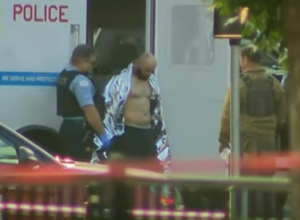A high-stakes standoff on Chicago’s West Side culminated in the arrest of a fugitive who had been eluding law enforcement since mid-June. The tense situation, which began late at night and stretched into the following morning, took place just a few blocks from the United Center, drawing the attention of local residents and a significant law enforcement presence.

Details of the Standoff
The standoff occurred at Seafood Junction, a restaurant located on the 2300 block of West Madison Street. This establishment, now temporarily closed due to the events that transpired, became the unlikely setting for the dramatic capture. The fugitive, Joshua Zimmerman, was discovered hiding in the ceiling of the restaurant, ending a months-long manhunt. Zimmerman, who had escaped from a correctional facility in Mississippi, was wanted for a series of severe crimes, including attempted murder and armed robbery. He had been on the run since June 14th, prompting a multi-state search that finally led authorities to this Chicago neighborhood.
The standoff, which lasted nearly 17 hours, involved multiple law enforcement agencies, including U.S. Marshals, who had converged on the scene after receiving a critical tip. This tip, which directed them to Seafood Junction, was instrumental in narrowing down Zimmerman’s location. Upon arrival, officers quickly identified Zimmerman, who had been working at the restaurant under a false identity. In a desperate attempt to avoid capture, he barricaded himself in the ceiling of the restaurant, triggering a tense standoff that required careful negotiations and strategic planning by the authorities.
Capture of the Fugitive
After hours of negotiations and tactical maneuvers, law enforcement officials successfully apprehended Zimmerman without further incident. The meticulous operation underscored the complexity of capturing a fugitive who had managed to blend into a busy urban area despite his criminal background and fugitive status. The fact that Zimmerman had been employed at the restaurant and living under an assumed identity for several weeks raised immediate concerns among both the community and law enforcement.
The arrest of Zimmerman marked the end of a prolonged and tense situation, bringing relief to a community that had unknowingly harbored a dangerous fugitive. However, it also opened the door to numerous questions about how Zimmerman was able to evade capture for so long and how he managed to secure employment in a public-facing business despite being a wanted man.
Public Reaction and Concerns
The local community has expressed significant concern following Zimmerman’s arrest, particularly regarding the restaurant’s hiring practices. Questions have been raised about how someone with such a serious criminal background could have slipped through the cracks of the employment screening process. One local resident, who frequently visits the strip mall where Seafood Junction is located, voiced their worries about the restaurant’s apparent lack of stringent background checks. The resident suggested that businesses should implement more thorough vetting processes to prevent similar incidents in the future.
Adding to the community’s unease, a video obtained by CBS News Chicago surfaced, showing Zimmerman inside the restaurant earlier in the month. The footage, provided by an anonymous source, was pivotal in confirming Zimmerman’s identity. When compared with images of him that had been circulated on social media, the video led to his identification and subsequent arrest. The fact that Zimmerman had been living and working in the area without detection for weeks has only heightened concerns among residents about the potential risks posed by fugitives hiding in plain sight.
Investigation and Ongoing Questions
While the U.S. Marshals Service has confirmed that their investigation led them to Zimmerman’s location, many questions remain unanswered. Authorities are still trying to piece together the events that allowed Zimmerman to evade capture for over two months and eventually secure a job in Chicago. The journey from Mississippi to Chicago, how he managed to stay under the radar, and the network of support he may have relied on are all areas of ongoing investigation.
Moreover, the incident has cast a spotlight on the effectiveness of background checks in employment, particularly in public-facing businesses. The ability of a fugitive to obtain a job in a busy urban environment raises serious concerns about the potential for similar situations in the future. Law enforcement agencies are now looking into how Zimmerman was able to bypass these checks and what can be done to prevent such oversights in the future.
Conclusion
The nearly 17-hour standoff on Chicago’s West Side ended with the successful arrest of Joshua Zimmerman, a dangerous fugitive who had been on the run for over two months. While the community can breathe a sigh of relief following his capture, the incident has underscored critical issues surrounding employment background checks and the risks associated with fugitives blending into urban areas. As the investigation continues, both law enforcement and the public are eager for answers to the many questions that linger regarding Zimmerman’s time on the run and how he managed to evade authorities for such an extended period.














